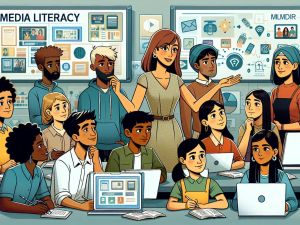Media Literacy Education Teacher Course
- Description
- Curriculum
- Reviews
Section 1: Introduction
Discover the genesis of Biasly and the importance of teaching media literacy in our increasingly digitized and politically polarized society. We will delve into the challenges of internet-borne misinformation and the impacts on younger, less politically informed demographics. Learn about our commitment to high-quality Media Literacy education through our courses and Biasly’s Media Education Literacy Platform (MLEP) and how it can benefit your students.
Section 2: Student Course
2.1 Course Overview
Understand the design and focus of our student program, which offers an interactive platform for students to learn about different types of media bias. Explore how the course empowers students to recognize the influence of media, introduces them to our rating methodologies, and teaches them to navigate through various biases present in online media.
2.2 How the Biasly course can help your students learn about media literacy
Get acquainted with Media Literacy and how this course can help students identify different types of media biases. Learn about the various functionalities of the MLEP platform to aid teachers in tracking student progress and performance.
Section 3: Administering the Course
Learn about the structure of the course, which begins with teaching students about different types of biases and their historical significance. Understand the practical aspects of the course, such as rating articles based on different elements and using our patented Bias Meter. Discover effective strategies for guiding students in their learning journey while maintaining neutrality.
By the end of the course, you will be equipped to deliver a comprehensive, engaging media literacy program that will prepare your students to become critical consumers of media.
Section 4: Media Literacy and Bias
4.1 What is Media Literacy?
Media Literacy encompasses the ability to access, analyze, evaluate, and create media across various forms. It involves identifying media biases, fake news, or harmful stereotypes in media, granting the ability to navigate the ‘media maze’ in ways that keep the consumers informed and educated. This section emphasizes the importance of continual study and practice in understanding the motives of the media and the political stakeholders influencing it.
4.2 How does bias show up in the media?
Bias in the media can appear in numerous ways and can drastically affect the perception of news among readers. This part provides a critical understanding of how bias manifests in media, often through tactics like clickbait and emotional triggers.
4.3 Types of Political Bias
Identification of political bias in media is essential to media literacy. This section delves into explaining two main types of bias – explicit and implicit and elaborates on how they reflect in media content.
4.4 How to share media bias examples in the classroom
Effective strategies to share media bias examples with students will be discussed here. Keeping in mind that every individual has political bias, it is crucial to maintain an apolitical stance while discussing such examples.
4.5 How to enable students to better understand political events on their own without influencing their political views
This segment focuses on how teachers can guide students toward understanding political events without imposing their views. It includes promoting the standard of fair and unbiased reporting, helping students rate articles independently, and navigating Biasly’s Media Source List. The aim is to equip students to analyze political topics on their own without influence.
Section 5: Using Media Literacy Education Platform (MLEP)
5.1 Administration of the software and feature overview
In this section, you will be familiarized with the MLEP program, which will be a cornerstone of your teaching and your students’ learning journey. It provides step-by-step instructions on how to create an account, enroll students, create classes, assign articles and quizzes, and monitor student progress using the instructor dashboard.
5.2 How to use the MLEP platform to accelerate student learning
Understanding the utilization of the MLEP platform is paramount in enhancing student learning. This part details how to assign articles, create courses of varying difficulty, and effectively use quizzes to test and reinforce the skills your students have learned.
5.3 Best practices on administering assessments and scoring
This segment offers guidelines on administering assessments, tracking student progress, and scoring. It highlights the importance of identifying struggling students and offering necessary intervention, ensuring all students can acquire the skills to evaluate media bias independently. By the end of their lessons, students will be equipped to accurately assess media bias, leading to a more informed and discerning understanding of politics.

